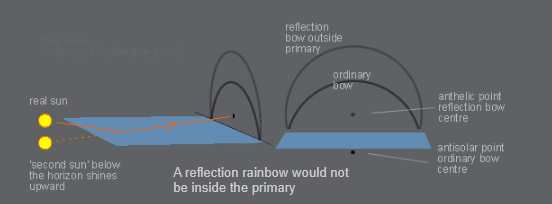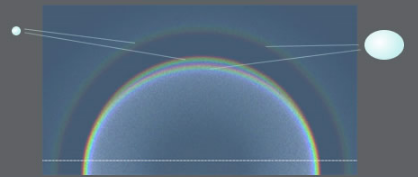OPOD - Anomalous Rainbows
OPOD - Anomalous Rainbows: Unraveling the Mystery of Peculiar Bows
Rainbows have long captivated our imaginations with their vibrant colors and ethereal beauty. We are familiar with the classic primary and secondary rainbows, but what about those rare and enigmatic anomalies that occasionally grace the sky? In this article, we will delve into the world of anomalous rainbows, exploring their origins, peculiarities, and the mysteries that surround them.
The Enigma of Anomalous Bows
In a picturesque scene captured by Yuan-Shu, Chang and Tien-Chu, Chang in Ilan, Taiwan, a peculiar quadruple rainbow unfolds before our eyes. What makes this sight truly extraordinary is the presence of two additional bows nestled within the primary rainbow. These extra bows are noticeably tilted, defying the conventional expectations of a typical rainbow formation.
Reflection Rainbows: A Mirage or Reality?
One might wonder if these anomalous rainbows could be attributed to reflection rainbows, formed by sunlight reflecting off smooth water surfaces. However, upon closer inspection, it becomes clear that these Taiwan bows cannot be explained by reflections alone. Unlike reflection rainbows, which appear inside the primary rainbow, these enigmatic bows consistently appear outside the primary, meeting at the horizon. Moreover, enhanced images reveal no evidence of extra color-reversed secondary bows typically associated with reflection rainbows.
Twins in the Sky: A Clue to Their Origin
To understand the origin of these peculiar bows, we must consider the phenomenon of twinning. During intense and stormy showers, it is possible for the primary rainbow to split into two distinct arcs while the secondary remains singular. This splitting occurs when drops of different sizes and degrees of flattening populate the atmosphere. The light paths generating the secondary bow are less sensitive to the drops' oblateness, resulting in an unsplit appearance.
In the case of the anomalous bows observed in Taiwan, the primary bow exhibits oddities, suggesting the presence of twinning. However, unlike fleeting moments of twinning typically observed during stormy weather, these bows are strongly separated and endure for an extended period. This unusual longevity suggests the existence of three separate populations of drops, each with identical sizes and degrees of flattening.
Exploring Possible Explanations
As we unravel the mysteries surrounding these anomalous rainbows, we are left with intriguing possibilities for their origin. While explanations involving massive tilted mirrors seem improbable, they are not entirely implausible. Alternatively, we could speculate that special and unlikely circumstances may play a role in their formation.
It is essential to note that even ordinary rainbows, the archetypal atmospheric optics effect, are themselves improbable occurrences. In most locations worldwide, excluding areas like Western Scotland, Ireland, Hawaii, and Patagonia, witnessing more than six rainbows in a year is considered fortunate. This rarity only adds to the allure and fascination of these captivating natural phenomena.
Beyond Rainbows: Exploring the Vast Sky Optics
While rainbows hold a special place in our hearts, they are just one of many celestial displays that grace our skies. Halos and other atmospheric optical phenomena occur more frequently and offer an array of breathtaking sights. These phenomena include sundogs, light pillars, circumzenithal arcs, and many more. Each holds its own unique beauty and can be observed under specific atmospheric conditions.
As we continue to explore the wonders of atmospheric optics, let us embrace the perplexity and burstiness that arise from the intricate interplay of light, moisture, and particles in our atmosphere. The study of these phenomena not only deepens our understanding of the natural world but also serves as a reminder of the awe-inspiring marvels that surround us every day.
Conclusion
Anomalous rainbows stand as a testament to the boundless complexity and beauty of our natural world. While their origins remain shrouded in mystery, we have unraveled some of the secrets behind these captivating phenomena. From the unusual twinning observed in the primary bow to the absence of color-reversed secondary bows, each piece of the puzzle brings us closer to a comprehensive understanding of these enigmatic spectacles. As we gaze upon the sky, let us embrace the wonders of atmospheric optics and revel in the unexpected surprises that nature has in store for us.
 Anomalous Bows
Anomalous Bows
A peculiar quadruple rainbow imaged by Yuan-Shu, Chang and Tien-Chu,Chang in Ilan, Taiwan. Just three minutes later (below) the fourth bow had disappeared but the third and mysterious bow remained.
©Yuan-Shu, Chang and Tien-Chu,Chang

What is happening here? At the left is a perfectly ordinary secondary rainbow. To its right is a normal primary. Inside the primary are two extra bows, oddly canted.
Could they be reflection rainbows formed by upwards mirrored sunlight from smooth water?
When that happens, falling raindrops see two suns, one above the horizon and one below it, and thus form two separate sets of bows. Yet these Taiwan bows cannot come from reflections. They are always outside the primary - diagram below. They meet at the horizon. When the sun is away from the horizon as here, the reflection bow is angled sharply away from the ordinary primary. Only two immense mirrors tilted so that sunlight almost grazed their surfaces could have manufactured the Taiwan bows.
A clue to their origin is that there are no extra colour reversed secondary bows visible even when the images are severely enhanced. That suggests twinned bows. Sometimes, during a very violent and stormy shower, the primary splits into two but the secondary stays single. Two separate populations of drops with different amounts of flattening make the twins. The different light paths generating the secondary are much less sensitive to the drops’ oblateness and that bow is unsplit.
Usually, twinning usually lasts only moments , there was no story weather here and the bows are strongly separated. The primary plus oddities would need three separate sets of drops with the drops in a set all having the same size and so degree of flattening. Less improbable than some huge tilted mirrors but explanations invoking special and unlikely circumstances are never appealing.
Yet even ordinary rainbows, the archetypal atmospheric optics effect, are improbable In most locations (let’s exclude Western Scotland, Ireland, Hawaii and Patagonia!) you will be lucky to see more than six a year. Many halos and other sky optics can be seen much more often.

A reflection rainbow would not be inside the primary

A twinned bow is usually inside the primary but needs very special conditions to form. Ray tracing by a HaloSim modification
Note: this article has been automatically converted from the old site and may not appear as intended. You can find the original article here.
Reference Atmospheric Optics
If you use any of the definitions, information, or data presented on Atmospheric Optics, please copy the link or reference below to properly credit us as the reference source. Thank you!
-
<a href="https://atoptics.co.uk/blog/opod-anomalous-rainbows/">OPOD - Anomalous Rainbows</a>
-
"OPOD - Anomalous Rainbows". Atmospheric Optics. Accessed on April 20, 2024. https://atoptics.co.uk/blog/opod-anomalous-rainbows/.
-
"OPOD - Anomalous Rainbows". Atmospheric Optics, https://atoptics.co.uk/blog/opod-anomalous-rainbows/. Accessed 20 April, 2024
-
OPOD - Anomalous Rainbows. Atmospheric Optics. Retrieved from https://atoptics.co.uk/blog/opod-anomalous-rainbows/.